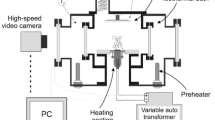Abstract
Application of the method of layer-by-layer selective laser sintering of a metal powder for depositing capillary-porous coatings with a prescribed porosity onto heat-releasing surfaces is considered. Implementation of this method in experimental investigations of the boiling process on modified surfaces allows broad-range variations of the main parameters of microstructured capillary-porous coatings and other three-dimensional structures: material, porosity, amplitude (height), thickness of the residual layer and wavelength of capillary-porous coatings, and size and shape of three-dimensional ordered microtextures. It is demonstrated that the use of this technology can increase the heat transfer coefficient the case of boiling on the surface with a capillary-porous coating by several times as compared to the uncoated surface.
Similar content being viewed by others
References
G. Liang and I. Mudawar, “Review of Pool Boiling Enhancement by Surface Modification,” Intern. J. Heat Mass Transfer 128, 892–933 (2019).
L. Lin and M. A. Kedzierski, “Review of Low-GWP Refrigerant Pool Boiling Heat Transfer on Enhanced Surfaces,” Intern. J. Heat Mass Transfer 131, 1279–1303 (2019).
M. E. Poniewski and J. R. Thome, Nucleate Boiling on Micro-Structured Surfaces (Heat Transfer Research. College Station, TX, 2008).
I. A. Popov, Kh. M. Makhyanov, and V. M. Gureev, Physical Fundamentals and Industrial Applications of Heat Transfer Intensification: Intensification of Heat Transfer (Center of Innovative Technologies, Kazan’, 2009) [in Russian].
A. S. Surtaev, V. S. Serdyukov, and A. N. Pavlenko, “Nanotechnologies in Thermophysics: Heat Transfer and Crisis Phenomena in Boiling,” Ross. Nanotekhnol. 11(11–12), 18–32 (2016).
C. M. Patil and S. G. Kandlikar, “Review of the Manufacturing Techniques for Porous Surfaces used in Enhanced Pool Boiling,” Heat Transfer Eng. 35(10), 887–902 (2014).
D. E. Kim, D. In. Yu, D. W. Jerng, et al., “Review of Boiling Heat Transfer Enhancement on Micro/Nanostructured Surfaces,” Experimental Thermal Fluid Sci. 66, 173–196 (2015).
D. H. Min, G. S. Hwang, Y. Usta, et al., “2-D and 3-D Modulated Porous Coatings for Enhanced Pool Boiling,” Intern. J. Heat Mass Transfer 52(11–12), 2607–2613 (2009).
V. I. Zhukov and A. N. Pavlenko, “Heat Transfer and Critical Phenomena during Evaporation and Boiling in a Thin Horizontal Liquid Layer at Low Pressures,” Intern. J. Heat Mass Transfer 117, 978–990 (2018).
V. I. Zhukov and A. N. Pavlenko, “Regimes of Intensified Heat Transfer during Evaporation of Thin Horizontal Liquid Layers at Reduced Pressures,” Techn. Phys. Lett. 44(6), 508–510 (2018).
V. I. Zhukov, A. N. Pavlenko, and V. P. Bessmeltsev, “Heat Transfer at Evaporation and Boiling in Thin Horizontal Liquid Layers on Smooth and Micro-Structured Surfaces under Low Pressures,” J. Phys.: Conf. Ser. 1105, 012054 (2018).
A. S. Surtaev, A. N. Pavlenko, D. V. Kuznetsov, et al., “Heat Transfer and Crisis Phenomena at Pool Boiling of Liquid Nitrogen on the Surfaces with Capillary-Porous Coatings,” Intern. J. Heat Mass Transfer 108, 146–155 (2017).
C. Zhang, L. Zhang, H. Xu, et al., “Performance of Pool Boiling with 3D Grid Structure Manufactured by Selective Laser Melting Technique,” Intern. J. Heat Mass Transfer 128, 570–580 (2019).
V. P. Bessmeltsev, N. V. Goloshevskii, V. V. Kasterov, et al., “Method of Calibration of a Laser-Based Galvanometric Scanning System with Submicron Resolution,” Avtometriya 54(4), 84–92 (2018) [Optoelectron., Instrum. Data Process. 54 (4), 390–396 (2018)].
V. P. Bessmeltsev, N. V. Goloshevskii, and K. K. Smirnov, “Specific Features of Controlling Laser Systems for Micromachining of Moving Carriers,” Avtometriya 46(1), 98–106 (2010) [Optoelectron., Instrum. Data Process. 46 (1), 79–86 (2010)].
A. N. Pavlenko and V. V. Lel, “Heat Transfer and Crisis Phenomena in Falling Films of Cryogenic Liquid,” Russ. Journ. Eng. Thermophys. 7(3–4), 177–210 (1997).
A. Jaikumar and S. G. Kandlikar, “Pool Boiling Inversion through Bubble Induced Macroconvection,” Appl. Phys. Lett. 110, 094107, 107–113 (2017).
Author information
Authors and Affiliations
Corresponding author
Additional information
Russian Text © The Author(s), 2019, published in Avtometriya, 2019, Vol. 55, No. 6, pp. 25–35.
About this article
Cite this article
Bessmeltsev, V.P., Pavlenko, A.N. & Zhukov, V.I. Development of a Technology for Creating Structured Capillary-Porous Coatings by Means of 3D Printing for Intensification of Heat Transfer during Boiling. Optoelectron.Instrument.Proc. 55, 554–563 (2019). https://doi.org/10.3103/S8756699019060049
Received:
Revised:
Accepted:
Published:
Issue Date:
DOI: https://doi.org/10.3103/S8756699019060049




